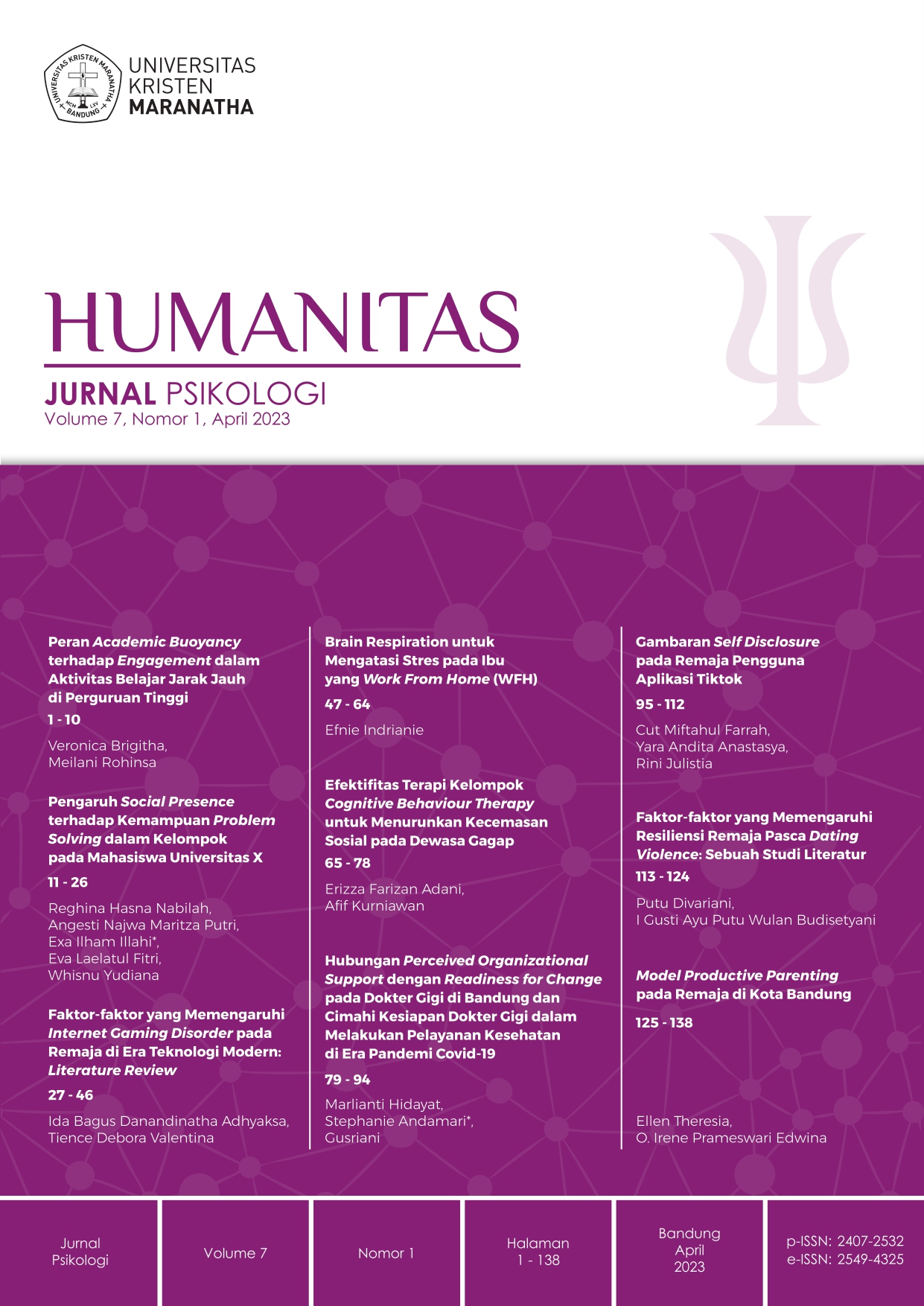Efektifitas Terapi Kelompok Cognitive Behaviour Therapy untuk Menurunkan Kecemasan Sosial pada Dewasa Gagap
Isi Artikel Utama
Abstrak
Unduhan
Rincian Artikel

Artikel ini berlisensi Creative Commons Attribution-NonCommercial 4.0 International License.
Referensi
Ahmed, H. H., & Mohammed, H. O. (2018). Social anxiety disorders among stutterers: effects of different variants. Egyptian Journal of Otolaryngology, 34(2), 155–164. https://doi.org/10.4103/ejo.ejo_72_17
American Psychiatric Association. (2013). Diagnostic and Statistical Manual of Mental Disorders (5th ed.). Arlington: American Psychiatric Publishing.
Corey, G. (2016). Theory and practice of group counseling (9th ed.). Belmont: Cengage Learning..
Hastjarjo, T. D. (2019). Rancangan Eksperimen-Kuasi. Buletin Psikologi, 27(2), 187. https://doi.org/10.22146/buletinpsikologi.38619
Iverach, L., Menzies, R., Jones, M., O’Brian, S., Packman, A., & Onslow, M. (2011). Further development and validation of the Unhelpful Thoughts and Beliefs About Stuttering (UTBAS) Scales: Relationship to anxiety and social phobia among adults who stutter. International Journal of Language and Communication Disorders, 46, 286–299.
Iverach, L., Heard, R., Menzies, R., Lowe, R., O’Brian, S., Packman, A., & Onslow, M. (2016). A Brief Version of the Unhelpful Thoughts and Beliefs About Stuttering Scales:The UTBAS-6. Journal of Speech, Language, and Hearing Research, 1-9. doi:10.1044/2016_JSLHR-S-15-0167
Iverach, L., Rapee, R. M., Wong, Q. J., & Lowe, R. (2017). Maintenance of Social Anxiety in Stuttering: A Cognitive-Behavioral Model. American Journal of Speech-Language Pathology, 1-17.
Kasbi, F., Mokhlesin, M., Maddah, M., Noruzi, R., Monshizadeh, L., & Khani, M. M. M. (2015). Effects of stuttering on quality of life in adults who stutter. Middle East Journal of Rehabilitation and Health, 2(1).
Lowe, R., Menzies, R. G., Packman, A., O’Brian, S., & Onslow, M. (2016). Observer perspective imagery with stuttering. International Journal of Speech-Language Pathology, 17, 481–488
Malhotra, A., & Baker, J. (2022). Group Therapy. In StatPearls. StatPearls Publishing.
Menzies, R. G., Onslow, M., Packman, A., & O’Brian, S. (2009). Cognitive behavior therapy for adults who stutter: A tutorial for speech-language pathologists. Journal of fluency disorders, 34(3), 187-200.
Reilly, S., Onslow, M., Packman, A., Cini, E., Conway, L., Ukoumunne, O. C., . . . Wake, M. (2013). Natural history of stuttering to 4 years of age: a prospective community-based study. Pediatrics, 132(3), 460–467. doi:10.1542/peds.2012-3067
Rice, K., Schutte, N. S., Rock, A. J., & Murray, C. V. (2021). Structure, Validity and Cut-Off Scores for the APA Emerging Measure: DSM-5 Social Anxiety Disorder Severity Scale (SAD-D). Journal of Depression and Anxiety. doi: 10.35248/2167-1044.21.10.406
Scheurich, J. A., Beidel, D. C., & Vanryckeghem, M. (2019). Exposure therapy for social anxiety disorder in people who stutter: An exploratory multiple baseline design. Journal of fluency disorders, 59, 21-32
Siswanti, A. S. (2021). Gangguan Kefasihan Onset Masa Kecil/Gagap. In D. K. Habsara, N. Kusumawardhani, A. R. Ibrahim, A. K. Putranto, W. Risnawaty, D. Suryadi, & I. P. Suryadinata (Eds.), Penatalaksanaan Gangguan Psikologis (1st ed., pp. 52-71). Yogyakarta: Pustaka Pelajar.
Yairi, E., & Ambrose, N. (2013). Epidemiology of Stuttering: 21st Century Advances. J Fluency Disord, 38(2), 66–87. doi:10.1016/j.jfludis.2012.11.002

